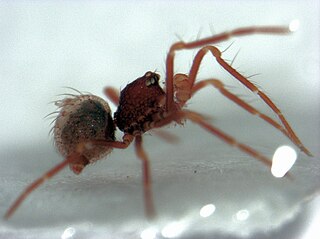
Novanapis is a genus of South Pacific araneomorph spiders in the family Anapidae, containing the single species, Novanapis spinipes. It was first described by Norman I. Platnick & Raymond Robert Forster in 1989, and has only been found in New Zealand.

Algidiella is a monotypic genus of spiders in the family Anapidae. It was first described by Rix and Harvey in 2010. As of 2023, it contains only one species, Algidiella aucklandica.

Pua novaezealandiae is a species of spiders in the family Anapidae. It is the only species in the genus Pua. It is found only in New Zealand.

Forstrarchaea is a monotypic genus of shield spiders from New Zealand containing the single species, Forstrarchaea rubra.
Pounamuella insula is a species of Orsolobidae. The species is endemic to New Zealand.
Tangata stewartensis is a species of Orsolobidae that is endemic to New Zealand.

Taphiassa punctata is a species of Anapidae that is endemic to New Zealand.
Rayforstia antipoda is a species of Anapidae that is endemic to New Zealand.
Rayforstia mcfarlanei is a species of Anapidae that is endemic to New Zealand.
Rayforstia signata is a species of Anapidae that is endemic to New Zealand.
Rayforstia scuta is a species of Anapidae that is endemic to New Zealand.

Rayforstia wisei is a species of Anapidae that is endemic to New Zealand.
Paranapis insula is a species of Anapidae that is endemic to New Zealand.
Zealanapis insula is a species of Anapidae that is endemic to New Zealand.
Runga raroa is a species of Physoglenidae spider endemic to New Zealand.
Mangua forsteri is a species of Physoglenidae spider endemic to New Zealand.
Plectophanes frontalis is a species of Cycloctenidae spider endemic to New Zealand.
Toxopsiella dugdalei is a species of Cycloctenidae spider endemic to New Zealand.
Toxopsiella minuta is a species of Cycloctenidae spider endemic to New Zealand.

Ahua insula is a species of Agelenidae that is endemic to New Zealand.







